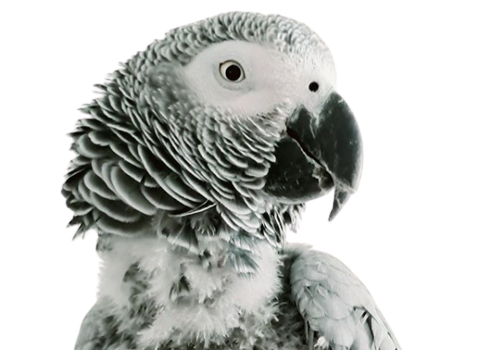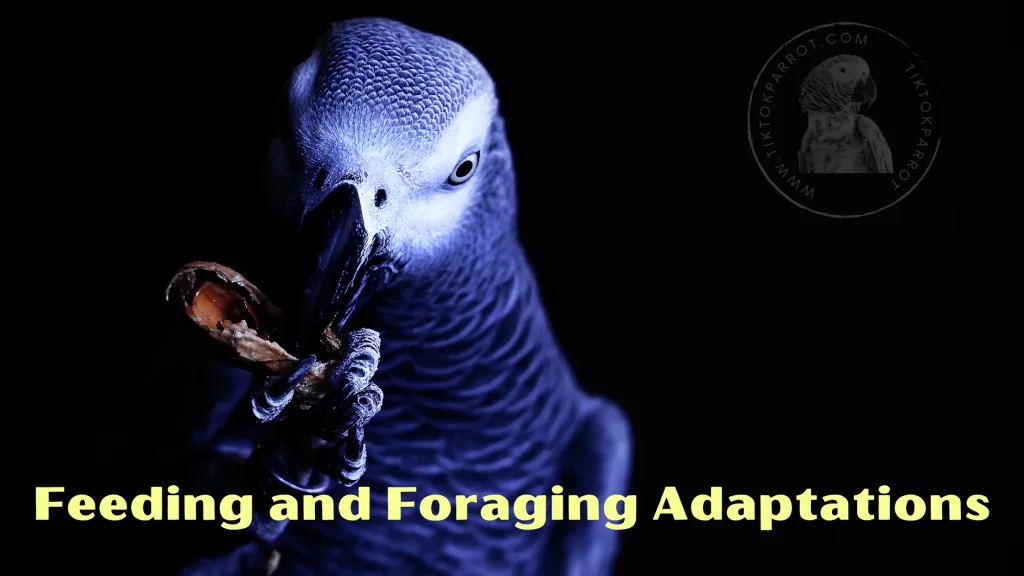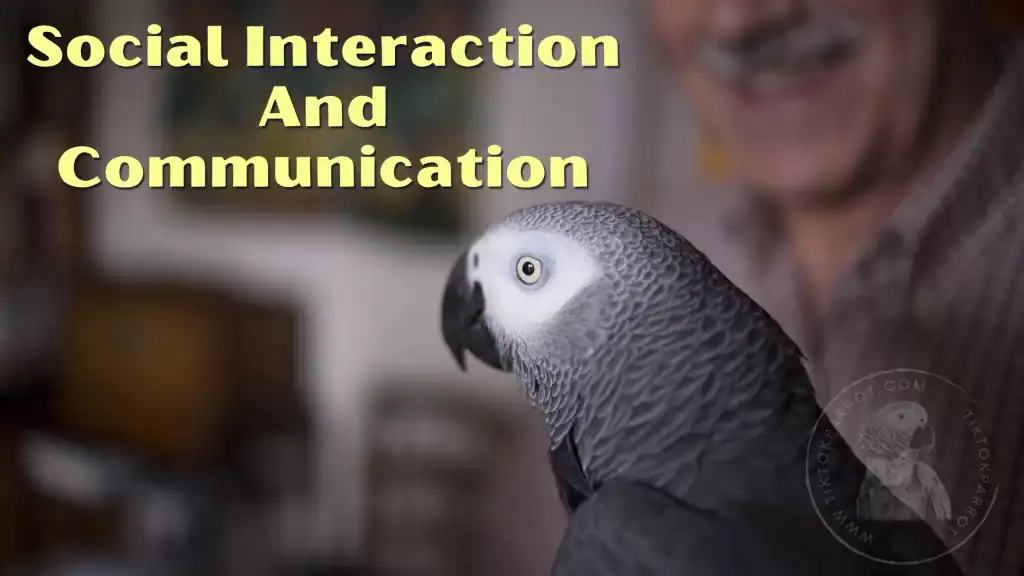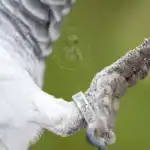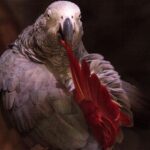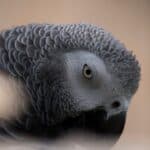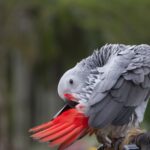The African grey parrots (Psittacus erithacus), also known as the Congo grey parrots are not only renowned for their remarkable intelligence, exceptional vocal mimicry skills, and striking appearance, but they also possess an extraordinary tool – their beaks.
The beak is a crucial and fascinating feature of these magnificent birds, playing a vital role in their daily lives. In this article, we will explore the unique characteristics and uncover the fascinating ways they utilize this powerful tool for survival and communication.
Discover the unique features of African grey parrot beaks, from their anatomy and structure to their essential roles in feeding, communication, and defense. Uncover the secrets of these mighty beaks!
Anatomy and Structure
The beak of the African grey parrot is a masterpiece of nature’s engineering. It is composed of two main parts: the upper mandible (maxilla) and the lower mandible (mandibula).
The beak’s outer layer, known as the rhamphotheca, is made of keratin, the same material found in human hair and nails. This layer is continually growing and wearing down, ensuring the beak remains sharp and functional. It is also surrounded by a fleshy structure called the cere, which houses the bird’s nostrils.
The upper mandible is curved and hooks over the lower mandible, allowing for excellent grip and leverage. The lower mandible is shorter and thicker, providing a stable base for the upper mandible to work against. The beak is also equipped with a hinge mechanism at its base, giving it the ability to open widely, which is essential for feeding and preening.
The beak’s structure allows the grey parrot to exert immense pressure when needed, making it a powerful tool for crushing, breaking, and manipulating various objects.
Incredible Strength
African grey parrots are known for their powerful beaks, capable of exerting tremendous pressure. The incredible strength of the African grey parrot’s beak is a testament to its adaptation for survival and feeding. Composed of keratin, the beak’s formidable structure enables the bird to exert immense pressure, allowing it to crack open even the hardest of nuts and seeds with ease.
The powerful bite force generated by the curved upper mandible and shorter lower mandible is not only essential for their diet but also acts as a potent defense mechanism against potential predators.
We can say the African grey parrot’s mighty beak is truly an impressive and versatile tool, reflecting the bird’s resourcefulness and adaptability in its natural environment.
This strength enables them to crack open even the hardest of nuts and seeds, which make up a significant portion of their diet in the wild. This force, combined with the beak’s sharp edges, also allows them to tear off pieces of fruit or chew through tough plant material.
Precision and Dexterity
One of the most remarkable features of the grey parrot’s beak is its dexterity. The beak acts as a third hand, helping the parrot manipulate objects.
The parrot’s beak is not only a powerful tool, but it also possesses remarkable precision and dexterity, making it highly versatile for various tasks. These birds have exceptional control over their beaks, allowing them to manipulate objects with great accuracy and finesse.
This incredible dexterity is crucial for tasks such as foraging, where they skillfully strip bark and leaves from branches to uncover hidden insects, or when feeding on fruits and seeds by delicately extracting the edible parts.
African Grey Parrots are also known for their ability to use their beaks to hold and manipulate objects like a third hand, showcasing their impressive level of coordination and adaptability.
Beak Growth and Maintenance
The beak of an African grey parrot undergoes continuous growth and maintenance throughout its life, ensuring it remains a functional and efficient tool for the bird.
Made of keratin, the beak grows steadily and must be worn down to maintain its shape and prevent overgrowth. African greys achieve this by grinding the upper and lower mandibles against each other and by chewing on various materials such as wood, bark, or toys provided by their caretakers.
Proper beak maintenance is crucial for the bird’s overall health, as an overgrown or damaged beak can lead to difficulties in feeding and grooming. This ongoing process highlights the importance of the African grey’s beak for its survival and the bird’s innate ability to self-regulate its growth and upkeep.
Feeding and Foraging Adaptations
The mighty beak of the African grey parrot is perfectly adapted for a diverse diet consisting of fruits, seeds, nuts, and vegetation. The parrot’s beak is ingeniously adapted for feeding and foraging, enabling the bird to thrive on a diverse diet in its natural environment.
The beak’s incredible strength not only allows it to crack open hard-shelled nuts and seeds with ease, while its precision and dexterity make it possible to skillfully extract the nutritious contents.
In addition to feeding, the beak is equally efficient in foraging activities. African greys use their beaks to manipulate and strip bark from branches, uncovering hidden insects that form a vital part of their diet.
The exceptional capabilities of the grey parrot’s beak in feeding and foraging demonstrate its remarkable adaptability and resourcefulness in sustaining its nutritional needs.
Additionally, their beaks are ideal for foraging, as they can effortlessly manipulate and strip bark to uncover hidden insects.
Social Interaction and Communication
African grey parrots also use their beaks as a means of communication and social interaction.
Parrot’s beak plays a remarkable role in facilitating social interaction and communication within the species. These intelligent birds utilize their beaks in a variety of gentle behaviors, such as nibbling or beak tapping, which serve as greetings, bonding exercises, or playful interactions among flock members.
Additionally, African greys engage in a behavior known as allopreening, where they use their beaks to groom one another, helping to maintain feather health while simultaneously strengthening social bonds. These subtle yet meaningful beak interactions exemplify the sophisticated communication skills of African Grey Parrots, highlighting their complex social dynamics and emotional intelligence.
Furthermore, grey parrots are known to use their beaks to groom one another, a behavior known as allopreening. This activity strengthens social bonds and helps maintain the health of their feathers.
Defense Mechanism
In the wild, the African grey parrot’s beak serves as an incredible defense mechanism, protecting the bird from potential threats in its natural habitat. When confronted by predators such as snakes, eagles, or monkeys, the parrot can deliver a powerful bite using its strong, hook-shaped beak. This forceful bite can deter the attacker, allowing the grey to escape unharmed.
When threatened, the bird can deliver a powerful bite, deterring potential attackers and protecting itself from harm. This capability is essential for the survival of these birds in their natural habitat, where they face threats from a variety of predators.
In addition to its impressive strength, the beak’s precision and dexterity enable the bird to target vulnerable areas on the predator’s body, further enhancing its defensive capabilities. This remarkable defense mechanism showcases the adaptability and resilience of African greys in the face of danger.
Frequently Asked Questions About African Grey Parrot’s Beak
- Q: What is the African Grey Parrot’s beak made of?
A: The beak is made of keratin, a strong protein found in nails, hair, and feathers. - Q: How do African Grey Parrots maintain their beak’s health and shape?
A: They grind their upper and lower mandibles against each other and chew on various materials such as wood, bark, and toys provided by their caretakers. - Q: How do African Grey Parrots use their beaks for feeding and foraging?
A: Their beaks are strong enough to crack open hard-shelled nuts and seeds, while the sharp tip allows them to skillfully extract the contents. They also use their beaks to manipulate and strip bark to uncover hidden insects. - Q: How do African Grey Parrots use their beaks for social interaction and communication?
A: They engage in gentle nibbling or beak tapping as a form of greeting, bonding, or play, and they use their beaks to groom one another in a behavior known as allopreening. - Q: How does the African Grey Parrot’s beak serve as a defense mechanism?
A: When threatened, the bird can deliver a powerful bite with its strong beak, deterring potential attackers and protecting itself from harm. - Q: Do African Grey Parrots need any special beak care in captivity?
A: Providing them with appropriate toys and materials to chew on helps them maintain their beak’s shape and health. However, if you notice any issues like overgrowth or damage, consult an avian veterinarian for professional advice and care. - Q: How does the beak’s anatomy contribute to the African Grey Parrot’s impressive strength and dexterity?
A: The beak is composed of an upper mandible that is slightly curved and hook-shaped, and a shorter lower mandible, allowing the bird to exert immense pressure when needed and manipulate objects with precision. - Q: How often do African Grey Parrots need to grind their beaks to maintain their shape?
A: Beak grinding is a natural behavior that occurs throughout their life. There is no specific frequency, as the birds will instinctively grind their beaks as needed to maintain their shape and health. - Q: Can African Grey Parrots use their beaks to hold and manipulate objects like a third hand?
A: Yes, African Grey Parrots have exceptional control over their beaks and can use them to hold and manipulate objects with great accuracy and finesse, similar to how humans use their hands. - Q: What is the cere, and how is it related to the African Grey Parrot’s beak?
A: The cere is a fleshy structure surrounding the base of the beak. It houses the bird’s nostrils and is responsible for protecting the delicate nasal passages. - Q: How can I ensure that my African Grey Parrot has the proper materials to maintain its beak health in captivity?
A: Provide a variety of safe, bird-appropriate chew toys and materials such as wood, rope, and natural fibers, which encourage beak grinding and help maintain beak health. Rotate toys regularly to keep your parrot engaged. - Q: Is it normal for African Grey Parrots to bite or chew on their cage bars?
A: Chewing on cage bars is a common behavior in parrots, including African Greys. However, excessive bar chewing may indicate boredom, stress, or lack of appropriate toys and materials for beak maintenance. Ensure that you provide a stimulating environment with suitable toys and monitor your parrot’s behavior to address any underlying issues. - Q: How can I safely handle my African Grey Parrot without risking a bite from its strong beak?
A: To avoid bites, it’s important to build trust and establish a positive relationship with your African Grey Parrot. Learn to recognize their body language and signs of discomfort, and avoid pushing them beyond their comfort zone. Use positive reinforcement training to encourage desired behaviors and ensure that interactions are rewarding and enjoyable for both you and your parrot. - Q: How can I tell if my African Grey Parrot’s beak is overgrown or unhealthy?
A: Signs of an overgrown or unhealthy beak include difficulty eating, abnormal beak shape, misalignment of the upper and lower mandibles, or flaking and cracking. If you suspect any issues with your parrot’s beak, consult an avian veterinarian for a professional assessment and care. - Q: Can an African Grey Parrot’s beak change color or appearance over time?
A: Yes, an African Grey Parrot’s beak may change color slightly as it grows and matures. However, significant changes in color or appearance may indicate underlying health issues and should be evaluated by an avian veterinarian. - Q: Do African Grey Parrots use their beaks to climb or move around their environment?
A: Yes, African Grey Parrots often use their beaks as an additional point of support when climbing or navigating their environment, both in the wild and in captivity. - Q: Can African Grey Parrots break or damage their beaks, and if so, what can be done to help them?
A: While it is relatively uncommon, African Grey Parrots can experience beak injuries due to accidents or improper care. In such cases, immediate consultation with an avian veterinarian is essential. Depending on the severity of the injury, the veterinarian may need to trim or reshape the beak and provide further treatment or care instructions. - Q: How can I prevent my African Grey Parrot from developing beak problems?
A: To promote good beak health, provide a well-balanced diet, appropriate chew toys and materials, and a clean, safe, and stimulating environment. Regularly monitor your parrot’s beak and overall health, and consult an avian veterinarian for routine checkups or if you notice any concerns. - Q: How do African Grey Parrots use their beaks in conjunction with their tongues?
A: African Grey Parrots use their beaks and tongues together to manipulate food, extract seeds or nuts from shells, and to preen their feathers. The combination of their strong beak and highly dexterous tongue allows them to efficiently handle a variety of tasks related to feeding, grooming, and exploration.
My Closing Thoughts
The mighty beak of the African Grey Parrot is a truly unique and multifaceted tool that plays a vital role in the bird’s survival, feeding, social interaction, and communication. Understanding the complexities and functions of this powerful adaptation provides valuable insight into the fascinating lives of these intelligent and captivating creatures. So make sure, if you have a grey, the beak is well looked after 🙂
If you found this blog helpful, It would be great if you could share it with your family and friends who might find it useful as well.
You might like to read these as well 🙂
The Battle of the Birds: African Grey Parrot vs Macaw
African Grey Parrot Male or Female? (Determine Gender of African Grey)
Is Your African Grey a Jealous Bird? Here’s What You Need to Know!
The Surprising Benefits of Owning an African Grey Parrot
African Grey Parrots: The Ultimate Guide to Care and Training
Unlock the Secrets of Choosing the Perfect African Grey Parrot
The Importance of a Cage for Your African Grey Parrot
Understanding of Grey Parrot’s Body Language
For more useful content about African grey parrots, you can subscribe my site with your email to get notification upon publishing a new blog, the subscribe box you can see on the right side of this page. Also if you get an alert on your web browser while browsing my site, allow it and that will also give you an alert whenever I publish a new blog. 🙂
Stay safe and much love !


If you are interested in supporting me, kindly consider utilizing my affiliate link for your Amazon purchases. Your support would be greatly appreciated
